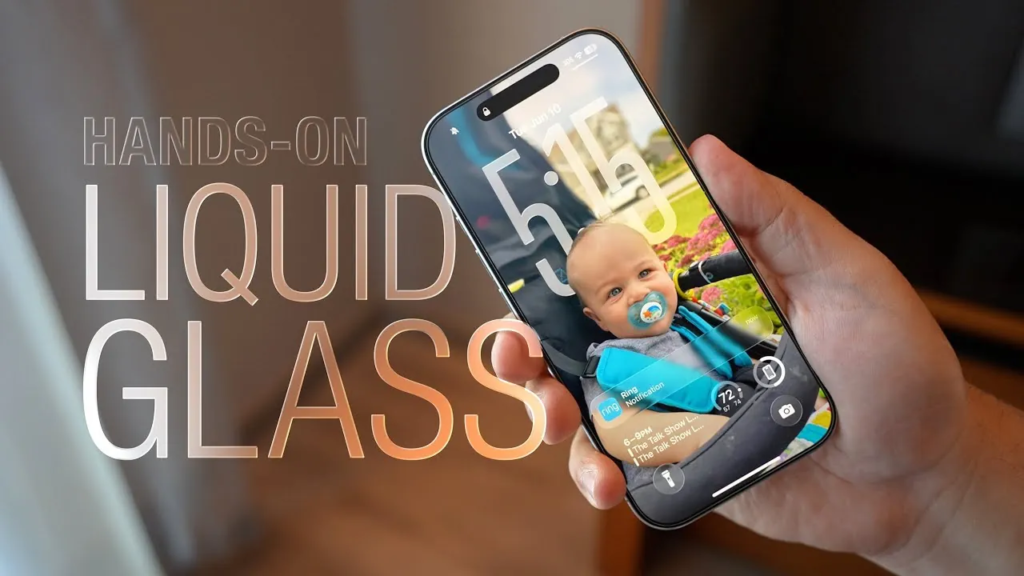Apple’s Worldwide Developers Conference (WWDC) 2025 ended with exciting announcements that push the boundaries of design, intelligence, and user experience. The highlight of the event was the introduction of a brand-new interface called Liquid Glass, along with powerful upgrades in iOS 26, macOS 26 “Tahoe”, and advanced features in visionOS.
The company focused heavily on integrating artificial intelligence into its ecosystem, showcasing a new direction in both functionality and design across devices. Apple’s aim is clear—build a smarter, cleaner, and more personal experience.
Liquid Glass: A New UI Era Across Apple Devices
The biggest visual change from Apple this year is the Liquid Glass UI. This design overhaul brings depth, fluidity, and responsiveness to all major Apple platforms. Transparent interface layers, dynamic blur effects, and soft motion transitions give apps and system elements a smooth, glass-like feel.

According to Apple, Liquid Glass is built on updated rendering architecture, which is optimized for the latest Apple Silicon chips. This new UI is not only about looks. It responds in real time to your actions, adjusting lighting, depth, and animations based on your interactions.
Apple says this new design will improve usability, accessibility, and comfort for users across iPhone, iPad, Mac, and Vision Pro.
iOS 26: Intelligence, Privacy, and Simplicity
The official unveiling of iOS 26 brings several intelligent new features to iPhones. Built on the foundation of Apple Intelligence Core, this update focuses on personalization and performance.
Key features in iOS 26 include:
- AI Smart Summaries: Apple’s core apps like Safari, Mail, and Messages can now generate on-the-go summaries using device-based AI.
- Dynamic Widgets 2.0: These widgets change based on time, place, or usage, offering personalized shortcuts throughout the day.
- Privacy Locker: A new way to protect apps with Face ID and passkey-based locks.
- Health App Upgrades: Enhanced mental health tracking that detects stress levels based on speech and facial cues.
- Faster Siri: Thanks to on-device intelligence, Siri now gives quicker and more accurate answers.
Apple confirmed that iOS 26 will be available to all iPhones from the iPhone 14 and up. Developers can access the beta now, and the public beta is expected in July 2025, with a final release scheduled for September.
macOS 26 “Tahoe”: Power and Clarity for Mac Users
macOS 26 “Tahoe” brings a clean and fast experience to MacBooks and iMacs. Named after the scenic Lake Tahoe, the OS focuses on productivity and design clarity, now fully integrated with the Liquid Glass UI.
Top features include:
- Cloud App Launching: Use apps instantly from iCloud Drive without waiting for full downloads.
- Task Scene: Save multiple windows, apps, and desktops into one “scene” and reopen it anytime.
- Universal Clipboard AI: Copies can now suggest the best app or device for pasting your content.
- Safari Vision: A new Safari feature that provides AI-powered visual previews and audio summaries of web content.
macOS 26 supports Macs with M2 chips and later. Developers already have access, and public beta users can try it in early July.
visionOS: Apple Vision Pro Gets a Boost
For its mixed-reality headset platform, Apple introduced major updates to visionOS. These improvements include advanced 3D calling, better multitasking, and enhanced collaboration tools.
Noteworthy features:
- Spatial FaceTime 2.0: Calls now include real-time emotion tracking with full 3D avatars.
- Pinned AR Apps: Apps can be anchored in your room, allowing a more natural interaction flow.
- Collaboration in AR: Share and co-edit 3D models in real time with teammates.
The updates aim to make Apple Vision Pro more suitable for both casual and professional users, especially in creative industries and design.
Apple Intelligence Core (AIC): The Brain Behind It All
A standout from WWDC 2025 is Apple’s deep investment in AI, led by the new Apple Intelligence Core (AIC). Built into every major OS (iOS, macOS, visionOS, and iPadOS), this AI engine runs entirely on-device, enhancing performance and keeping user data private.

AIC powers:
- Smart Siri interactions
- Language translation
- Email suggestions
- Real-time planning and summaries
Because AIC works offline, it also reduces dependence on cloud services and boosts performance on Apple’s M-series chips.
Developer Tools: Swift 6.0 and Xcode 17
Apple made sure developers were not left out. Xcode 17 was announced with faster build speeds, better Swift previews, and direct AR prototyping tools.
The launch of Swift 6.0 also includes support for parallel programming and cleaner syntax—features that make development for visionOS and AI-based applications easier and more efficient.
Developers can now explore tools like:
- AI APIs integrated into native frameworks
- Swift concurrency improvements
- Cloud simulator for multi-platform testing
Apple is making a clear push to create a unified, AI-first development environment.
A Glimpse Into Apple’s Future
WWDC 2025 gave developers, creators, and everyday users a look into Apple’s most unified and intelligent ecosystem to date. With stunning design from the Liquid Glass UI, smarter devices powered by Apple Intelligence Core, and highly productive updates to iOS 26, macOS 26, and visionOS, the company has taken a big leap forward.
These upgrades promise a future where software understands users better, looks beautiful, and works seamlessly across every screen—whether it’s in your hand, on your desk, or in your eyes.
You can explore more details and sign up for betas at Apple’s official developer portal.
Also Read – Google I/O Unveils Gemini AI, XR Glasses & Android 16






